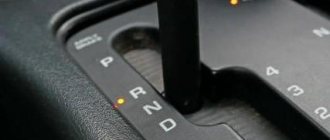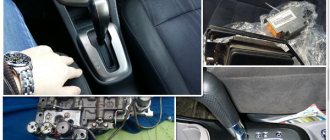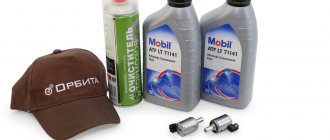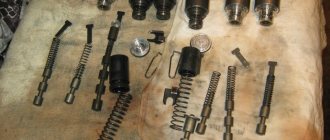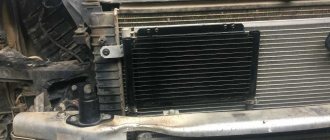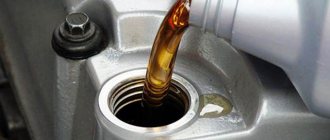What are solenoids in the automatic transmission of an excavator, what are they for, what are they?
The automatic transmission solenoid is an electromagnetic valve-regulator that closes and opens the oil channel. Its operation is regulated by an electronic control unit. The ECU sends constant electrical impulses at a certain frequency.
The solenoid serves to control the oil pressure on certain clutch links, allowing quick gear changes or relieving transformer blocking. The automatic transmission solenoid takes part in adjusting the control of gearbox modes.
What are solenoids in an automatic transmission, how to check and replace them?
The automatic transmission solenoid is an electromagnetic valve-regulator that performs the work of closing and opening the oil channel. Its operation is controlled by an ECU, which sends continuous electrical impulses at a certain frequency. The solenoid controls the oil pressure on specific clutch links, quickly changing gears, or unlocking the hydraulic transformer. The automatic transmission solenoid is responsible for controlling the transmission modes. Interesting fact! The first solenoids for automatic transmissions were developed in the USA in the 80s and were installed on Chrysler cars - their appearance has remained unchanged to this day, installed on jeeps and pickups. The solenoid is quite simple in design. A metal rod that is wrapped in a spiral with direct current. It is movable inside and, under the influence of current, moves from the end of the spiral to the beginning, using a spring, blocking or opening the flow of oil. This design is typical for modern automatic transmissions and is convenient because in the event of a power failure, the spring automatically fires and shuts off the oil.
Where are the solenoids located?
The solenoid, or solenoid valve, according to general rules, is located in the valve body - the hydraulic valve plate.
In the hydraulic unit, it is inserted into the channel, where it is fastened to it using a bolt or a special pressure plate. At the other end, it is connected using a cable or electrical wiring plug to the automation control unit.
The automatic transmission solenoid is responsible for transmitting signals between the hydraulic and electrical systems. It combines them with the help of its functions. And often this combination gives failures, which are detected by the computer.
The automatic transmission has at least 4 solenoids. Their number depends on the complexity of the circuit and the number of stages.
The ECU cable and cable are often the cause of solenoids failure, so they are replaced as quickly as the solenoid.
Types of solenoids
The first solenoids designed specifically for automatic transmissions were on-off solenoids of a fairly simple design and with simple functions. This type of solenoids worked on the principle of “open” and “close”. The rod, with the help of current running through the winding, moved along the channel and performed the on/off function.
Another excellent type of solenoids is the “solenoid valve” solenoid. This is perfect know-how for its time. It is actually a hydraulic valve. The developers gave it its own oil passage and a ball valve that opens and closes this oil passage. Easily disconnects from the hydraulic system and power supply by simply unplugging the plug. Interesting fact! This type of solenoids appeared in the mid-80s and is still installed on various executive cars - Buick, Oldsmobile, Chevrolet, Pontiac, etc.
The first of the solenoids operated on the on/off principle. But, due to the development of the auto industry, in the early 90s, 3-way solenoids were created - new generation switches. In the on position, the ball valve opens the passage for oil from channel 1 to channel 2, and in the off position, the passage from 2nd to 3rd. This development helped to combine devices into one - to turn on and off friction clutches.
Striving for perfection, designers in the mid-90s developed an even more “smart” type of solenoid. Solenoid regulators, or “electric regulators,” are designed on the principle of a valve. Depending on the type of pulse that comes from the computer, the internal curved section of the solenoid “opens” or “closes”, that is, the current is supplied at certain intervals and frequency.
Regulator solenoids can be ball, spool-type 3-way, 4-way, and even 5-way.
Ball valve solenoids - PWM solenoids - were developed. This is the first stage of development.
Later, quite rare VBS solenoids appeared. They have low sensitivity to supply pressure variations and cope well with high line oil pressures. They are also called spool valves, since they have a valve - a spool.
Linear (proportional) solenoids are designed in such a way that the most wearing element of the valve body plate, the coupling with holes along which the spool-plunger runs in this type of solenoid, is placed in the solenoid itself.
Linear solenoids are remarkable because with their help you can avoid replacing the entire hydraulic plate if this element breaks down, and limit yourself to replacing only one worn solenoid. The hydraulic plate now lasts longer, and the problem with wear of its channels has been eliminated.
Interesting fact! Linear solenoids were chosen by the supplier of automatic transmissions for Toyota - VAG-Volvo, the Japanese AT - Aisin Co. Subsequently, VFS (Variable Force Solenoid) solenoids were developed. Having a cheap and simple design, they are quite difficult to operate.
This type of solenoids is quite capricious, and the lifespan is shorter compared to linear solenoids. Because due to rapid wear due to light weight and increased pressure, the solenoid valve changes its opening level, and the computer needs precise communication to properly respond to such changes.
Solenoids are also distinguished according to their functional purpose:
- These are EPC or LPC (Line Pressure Control) solenoids. It is one of the first solenoid valves in a hydraulic platen. This type of solenoids is the “leader”. He single-handedly distributes the oil to the remaining solenoids and channels. With a 4-speed EPC, it wears out first.
- TCC solenoid. Performs the most “dirty” work among all types of solenoids. It affects the lock-up torque converter clutch, increasing efficiency for "sport mode" acceleration. It is often the weakest link in many hydraulic units, since unfiltered and hot oil from the torque converter flows through this solenoid.
- Shift solenoid. The so-called “shifter” is a solenoid switch. The simplest type of solenoids. Responsible for switching speeds. There are several such “shifters” in the hydraulic plate, and switching up and down in the box is done by them. They are designated as S1, S2, or A, B, and SL1 is a linear shifter.
Control Solenoid - Similar to the transistor in an electrical circuit, solenoids can control the valves of the cooker.
They direct and apply slight pressure to the valve body valve, which itself already supplies pressure to the pistons and clutches.
There are 2 types of control solenoids:
- — solenoid for high-quality gear shifting;
- — oil cooling control solenoid.
Main malfunctions of automatic transmission solenoids and their repair
Below we present the most common “diseases” of solenoids.
Important! For the long-term service of solenoids, it is not the production that is important, but the quality of the oil.
- The reason for breakdowns and “wedge” of solenoids is that due to low-quality oil, the solenoids become clogged with soot from paper, steel, bronze and aluminum dust, which is obtained from worn-out consumables and components.
This problem manifests itself in that the solenoid valve works normally when the oil is cold, but when it is hot it slows down.
To resolve this issue, it is recommended that the solenoid be rinsed, washed in solvents, and cleaned with AC and solvent.
- Leaks are a consequence of wear and tear of parts such as plungers and manifolds. If there are PWM solenoids in the control, when one of them is weakened, the computer takes into account its wear and redirects part of the load to other solenoids.
- The following problems and breakdowns are a decrease in the elasticity of the spring, cracks in the housing, a decrease in the resistance of the solenoid winding, and structural failures.
This slightly extends the life of the aged part. But hot oil and the intensity of the voltage quickly wear out the weak solenoid, and then it has to be replaced.
The intensity of work, when redirecting pressure and part of the responsibilities to other solenoids, wears out their channels and plungers. Thus, a continuous chain reaction is obtained.
The most common reason for solenoids to fail is wear of its parts: bushings, manifold, valve, plunger or ball.
The plunger becomes clogged with crumbs from worn parts and oil, it all starts with a problem with switching - it jams, then the amount of carbon deposits increases, and the bushings and valves fail. Interesting to know! The service life of the most reliable solenoids does not exceed 400 thousand km. Modern solenoid designs are much simpler than their predecessors. Hydraulic blocks were made of cast iron steel, and now they are made of aluminum. Previously, it was possible to fill in some kind of oil, but now the solenoids have become much softer.
But, nevertheless, due to all these innovations, fuel consumption decreased, the dynamics and comfort of the car increased, all automatic transmission mechanics began to work accurately, smoothly and loaded. But such changes, in turn, led to rapid wear of parts and contamination of the oil with their particles.
Now you need to constantly change the oil, as due to all these particles it acquires the properties of sandpaper.
How to check and replace solenoids
If you notice that it has become harder for you to shift gears into certain gears, or notice unknown chips in the pan, your computer gives you distress signals - looking for reasons to contact the solenoids directly.
It is quite easy to determine which solenoid is “sticking”. Each solenoid is responsible for a group of gears and control of the torque converter. It depends on the brand of your car and automatic transmission. For example, if there are 4 solenoids in the box, then the first is responsible for shifting 1-2 gears, and, most likely, 3-4 gears, the second is 2-3 gears, the third is for the torque converter unit, the fourth is responsible for the operation of the brake band. If there is a problem with shifting from 2-3 gears, then, accordingly, this solenoid must be repaired or replaced.
If you feel shocks and impacts in the gearbox while driving, or the computer itself tells you about the problem (a code is displayed, the light blinks, etc.), these cases indicate that you urgently need to check the valve body.
In these cases, it is necessary to immediately check the part. First of all, the solenoid is checked for resistance. A voltage of 12 V is supplied to the valve contact. If the solenoid is working, it will make a click, but if it does not, then the problem is that it is clogged. To clean under voltage, we blow it with compressed air - the solenoid should allow it to pass through. If not, it needs to be replaced.
Do-it-yourself repair of the solenoid is possible, but only in cases where the part itself is collapsible. Modern parts, for the most part, are now produced non-separable. For such parts, the only repair option is to blow them or use ultrasound. If the part is dismountable, then you can change the winding, wash all parts in gasoline, dry and reassemble. After these steps, we recommend checking the solenoid for functionality.
If you have failed to repair the solenoid, then replacing it in the automatic transmission is not difficult, the main thing is to do everything carefully and carefully. Before you begin, you need to determine the type of automatic transmission you have, and, based on this data, select the appropriate solenoid. We detach the valve body from the box, disconnect the solenoid from the power supply and remove it from the block. Next we install new parts. We install the valve body in its rightful place, not forgetting about the new gasket.
Subscribe to our feeds on Facebook, Vkontakte and Instagram: all the most interesting automotive events in one place.
Was this article helpful?
auto.today
Solenoid: how to check and why this element fails
So, the operation of the automatic transmission solenoids is controlled by the automatic transmission ECU. The control unit constantly sends pulse signals of a certain frequency to the valve. In simple words, the solenoid actually controls the oil pressure, which, in turn, is the working fluid in the machine device.
It is through the oil that torque is transmitted to the gas turbine engine, gears are changed, the torque converter is released, etc. It turns out that the automatic transmission solenoid controls the automatic transmission modes. The first solenoids replaced mechanical devices back in the 80s and since then have been actively used in automatic transmissions.
- Simply put, a solenoid is a device where a metal rod is wrapped in a spiral through which direct current flows. The rod in the housing is movable when a current acts on the spiral, this causes the rod to move from the end of the spiral to its beginning.
Also in the device of such a solenoid (electrovalve) there is a spring, which forcefully returns the rod to a given position. Without going into too much detail, the job of the solenoid is to close or open a passage for transmission oil.
The solenoids are located in the valve body (hydraulic valve plate, automatic transmission valve block) and are inserted into the channel, secured with a bolt and a pressure spring. Also connected to the solenoid is a cable or wiring connector for connection to the control unit (automatic transmission ECU).
In fact, the solenoid connects the hydraulics and electronics. Modern versions of automatic machines have at least four valves - solenoid. The total number depends on how many speeds a particular box has received, how complex it is structurally, etc.
- Please note that often problems in automatic transmission operation are associated with wiring failure, that is, the ECU simply loses connection with the valve and the automatic transmission cannot operate normally. It is also not uncommon for the solenoid itself to fail. When checking, it is important to consider what type of device is used on a particular automatic transmission, since there are several types of solenoids.
What are automatic transmission solenoids, typical problems
This concept is an electric solenoid valve controlled by an electronic control unit or mechatronics. It closes or opens a channel in the automatic transmission valve body (mechatronics) in order to control the gearbox directly. It is with the help of solenoids that the automatic transmission control unit directs transmission fluid under pressure into the clutch pack and changes gears. The solenoid consists of a bar magnet with a copper winding. Direct current flows there.
I will tell you about the operating principle of simple solenoids. If there is no voltage, the valve is retracted using a spring. As soon as voltage appears, the spring pushes the valve using the action of a magnetic field. Today they have a more complex structure. They can be controlled using pulse wide modulation and produce smooth switching. Such specimens are more expensive, but thanks to them there is no wear and tear on the hydraulic plate itself. You can just change the failed copy, and the problem will be resolved.
As you already understand, the solenoid regulates the channel in the hydraulic plate using an impulse and controls the flow of oil in the automatic transmission. With its help, all gearbox operating modes are switched.
Typical problems
Very often, solenoids become unusable due to burnout of the electrical winding. Carbon deposits appear on the plunger. It becomes clogged with very fine dust from various consumables and components. In such cases, the spool valve begins to jam either at operating oil temperature or “cold”. This can be easily corrected by washing in special solvents. Craftsmen use ultrasound or alternating current to clean parts. In some cases, the friction lining wears down to the adhesive substance. Then glue is added to the soot along with the dust. This will significantly complicate the repair procedure.
A popular cause of failure is also wear and tear on the components of the solenoid itself. It could be:
Most often, from my own experience, I can say that the plunger itself becomes clogged with products from wear of the clutches. Then switching problems appear. The carbon deposits that appear on the surface abrade the rubbing surfaces of valves and bushings. Bronze bushings wear out very often. There are special kits for replacing bushings yourself. They significantly extend the service life.
Solenoids have their own service life. It is calculated by the number of openings and closings. This figure falls within the range of 300,000 to 400,000 cycles. When exactly this happens does not always depend on mileage, but largely depends on the operation of the electronic control unit when you press the gas pedal. Some gearboxes have an operating mechanism in which some work an order of magnitude more intensely than others. As a result, they will use up the resource earlier.
Another common cause of breakdown is various mechanical damage (cracks) in the housing. Maybe the spring itself is not elastic enough. Or there was a break in the electrical winding.
How to check and replace solenoids?
How to recognize that you need to repair automatic transmission solenoids? The following typical signs will tell you about a breakdown:
- blows;
- tremors;
- jerks when changing gears,
- transition of the transmission to emergency mode.
If you notice that gears are shifted with jerks, this is exactly the case when you need to look into the automatic transmission solenoid block.
Due to lack of pressure, dry operation may occur. This will speed up the wear of the bushings significantly. The resulting vibration can damage the parts of the box to the point of being beyond repair. Various parts of the box may fail. For example, brake bands. This will happen if there is a malfunction for a long time.
You can check the serviceability yourself using an ohmmeter. If the solenoid has normal resistance, and when voltage is applied to it, you hear a click, it will be enough to simply flush it. But modern solenoids of a more complex design with an electrical regulator must be sent for computer diagnostics. The computer will display an error code. You can use this code to decipher the existing malfunction or entrust this matter to a specialist.
In order to independently cope with replacing solenoids in an automatic transmission, you must first determine the type of automatic transmission. As a rule, this information is indicated by the manufacturer in the form of a table pasted on the automatic transmission itself.
Find a new solenoid that matches your automatic transmission. You can carefully unscrew the block using a regular pry bar. Next, you should clean the seat from dust and remnants of the old gasket. The new block must be installed carefully and tightened gradually. After installation, you should test the car by switching speeds.
If you entrust the job to the craftsmen, they will additionally carry out a more thorough cleaning of dust from the place where the previous parts were installed. Most often, these parts are blown with compressed air.
The new unit must be installed quite carefully. If you overtighten it, it can be deformed and then its service life will be significantly reduced. Usually the entire procedure is accompanied by testing the car using computer diagnostics. The automatic transmission should make friends with them. After all the procedures, the computer should not produce errors. I advise you to go to an auto repair shop if you are not confident in your abilities. The choice is yours.
Video “Operation of automatic transmission solenoids”
The recording shows how automatic transmission solenoids work.
MineAvto.ru
Automatic transmission solenoids - operating principle and purpose
Automatic transmission solenoids are solenoid valves that are controlled by an electronic unit and are responsible for opening the channel for automatic transmission lubrication. It is the solenoids that provide high-quality lubrication and cooling of the internal elements of the automatic transmission. The solenoid itself consists of a magnet rod with a copper winding. Under voltage, the solenoid valve opens and closes the oil channel, through which the unit is cooled and lubricated.
The principle of operation of solenoids is quite simple. When there is no voltage, the valve is retracted by springs, closing the oil channel. As soon as voltage is applied to the winding under the influence of electric current and the resulting magnetic field, the spring pushes out the valve, thereby opening the oil channel. It must be said that today solenoids of a complex design are used, which are controlled by pulse-wide modulation. The use of such control technology makes it possible to smoothly open the valve, which in turn ensures the highest quality lubrication of the automatic transmission. It must be said that the advantage of using such solenoids with pulse-wide modulation control is the ability to replace failed elements one at a time. Whereas conventional valves are replaced as a whole set at once.
Signs of faulty solenoids:
You can determine the breakdown by indirect signs, which include:
- Frequent transition of the automatic transmission into emergency mode.
- The presence of sharp shocks when changing gears.
- Shocks in the box during a smooth increase in speed.
If you notice similar symptoms in your car, it is recommended that you contact a service center as soon as possible, where they will conduct a thorough check of the car and, if necessary, repair the automatic transmission.
Typical Solenoid Malfunctions
Like any other complex element, solenoids can fail. All breakdowns can be caused either by the end of their service life or by external factors. Let's talk in more detail about the causes of breakdowns of electric valves. The main reason why solenoids fail is the use of low-quality oil. A deposit of coking oil appears on the valve elements, which ultimately leads to the stem jamming in one position. The difficulty of repair in this case is that it is necessary to replace all solenoids, which has a high cost. That is why car manufacturers and specialists from service centers recommend regular automatic transmission oil changes and the use of high-quality consumables.
In some cases, the cause of failure of solenoid valves is a breakdown of the control unit that is responsible for their operation. This problem can only be determined by performing computer diagnostics of the car. Repair consists of replacing the failed unit. It should be said that, despite its relative simplicity, such repairs have a significant cost, which is explained by the price of the electrical control unit itself.
Aggressive driving - double load on solenoids
You also need to keep in mind the life of the solenoids. You should not think that such a valve is eternal and if all requirements for car servicing are met, the valves will never break. On average, modern solenoids have a guaranteed service life of 300-400 thousand cycles. Moreover, their service life depends not so much on the mileage of the car, but on the driving style of the car owner. If you practice aggressive driving and often press the gas pedal while actively shifting gears, this will soon damage the solenoid valves, which may require replacement literally after 100-150 thousand kilometers.
akpp-praktik.ru
Automatic transmission solenoids: history, structure, functions
The automatic transmission solenoid is a special device for controlling the movement of oil inside the valve body under commands from the electronic control unit. They are an electromechanical crane. They are the ones used to change gears and control the automatic transmission modes. All control circuits of modern hydraulic automatic machines, variators and robotic gearboxes are made on the basis of solenoids.
Appearance of automatic transmission solenoids
Previously, these functions were performed by mechanical valves. The first solenoids were introduced into automatic transmission designs in the eighties, in America, the country where automatic transmissions were actually invented and subsequently developed.
A solenoid is a fairly simple electromechanical device. A rod made of metal slides inside a conductive spiral, which is constantly exposed to direct current. When the current increases, the rod moves towards the end of the spiral, and when it decreases, it returns using a return spring. The rod itself blocks or opens the oil flow.
Automatic transmission solenoids are located inside the valve body; there are always several of them. Their number varies depending on the number of stages and the complexity of the control circuit, usually there are at least four. The solenoid is fixed into a special channel of the hydraulic plate using a bolt or other fastener and is connected through a connector to a cable or cable of the electric transmission control unit.
Disassembled gas block with solenoids
The solenoid has its own resistance, which can increase over time, leading to abnormal operation. Therefore, the solenoid is a consumable item; during any repair of the automatic transmission or flushing of the valve body, its resistance must be checked. Their abnormal operation can affect the functioning of the entire automatic transmission mechanism and cause it to fail. Solenoid wiring, especially those made in the form of cables, is not a reliable element and can often cause a malfunction. The self-diagnosis system of modern automatic transmissions can detect faulty solenoids and issue the corresponding error. You can carry out the diagnostic procedure yourself.
The valve body is usually located under the bottom of the box, but there are options for side placement.
Removing scratches on a car body without painting.
DON'T SPEND MONEY ON REPAINTING! Now you can remove any scratch from the body of your car in just 5 seconds.
Read more >>
First generation of solenoids
The first solenoids that became widespread worked on the “open-closed” (on-off) principle and are still in use today. They are responsible for completely opening or closing the valve body channels using a plunger around which a copper winding is located. Such devices have only two positions - open or closed. If the channel is closed by the solenoid, there is no oil pressure in it, but if it is open, then oil flows.
First generation solenoid
The second type of solenoids used in automatic transmissions is called a valve solenoid. It has the ability not only to completely open or close the flow of oil, but also to gently regulate its throughput. In modern automatic transmissions, this type of solenoids is practically not used due to their low reliability. The coil often short-circuited, the wiring burned out, the springs broke, became clogged with dirt or weakened.
Therefore, such mechanisms began to be made in the form of more reliable and advanced electric valves, which are still installed on a huge variety of different cars, even in the executive class.
Second generation of solenoids
Unlike the previous mechanism, the solenoid-electric valve has an oil channel with an inlet and an outlet and is essentially a hydraulic valve. The locking and unlocking of the oil flow in this solenoid is carried out by a ball valve made of metal. Despite the fact that this type of solenoids is more complex, its design is much more reliable. In addition, this type of solenoids is much easier to change; to do this, you just need to disconnect the connector and pull out the o-ring, due to which the solenoid holds pressure. The solenoid-electric valve, like electrical contacts, can be normally closed or normally open. This means that in its initial state such a solenoid is either open or closed, and under the influence of electric current it will return to the opposite position. While no current is supplied to the solenoid, it returns to its original position under the action of the return spring. When electric current is applied, the magnetic field generated by the winding will push the plunger in the opposite direction with a force sufficient to overcome the resistance of the return spring. In modern automatic transmissions, small metal filters are located in the solenoid channels, in the form of a mesh, which stop debris and prevent the solenoid or its channel from becoming dirty.
Second generation solenoids
3way
The next generation of solenoids was called 3way. Their internal channel already had three, rather than two, inputs. They performed the same function, but allowed pressure to be relieved from the clutch pack, performing two tasks at once, which allowed the use of just one solenoid to control the operation of one clutch pack.
Solenoid 3way
PWM, VFS and "proportional"
In the nineties, the design of solenoids became even more complex. Now the solenoids were required not only to open and close the oil flow, but also to provide smooth pressure control.
The operation of these solenoids became similar to the operation of a valve, rather than a faucet. Now there were not two provisions, but many. Depending on the command of the electronic control unit, they are able to smoothly open or close the channel, according to the calculated curve.
Instead of plungers, balls or spools are now used, 4Way and 5Way appear.
Proportional solenoid
Toyota's transmission subsidiary, Aisin, creates its own solenoid design, which it calls “proportional.”
This much more complex and technologically advanced device now includes ports that were previously part of the hydraulic valve plate and are controlled by a spool plunger to open or close them. The channels, which were previously located inside the hydraulic plate and were actively worn out by abrasive treatment with metal particles and debris in the oil, have now become part of the solenoid. If they wear out, there is no need to replace or restore the entire valve body - just change the solenoid itself. The service life of the hydraulic plate has increased significantly, and the most obvious problem of all modern automatic transmissions has been solved. The “proportional solenoids” themselves, of course, do not last very long, but they are also consumables - their replacement is very simple, you can do it yourself, and they are quite inexpensive in comparison with the valve plate. After 5–6 years, it is necessary to check their performance.
In modern automatic transmissions, these solenoids are also adjacent to conventional, “open-closed” types, but proportional ones do almost all the work, providing control of 4-5 oil flows each.
VFS or electric ball valves are widely used by ZF. They have a simpler and cheaper design. Instead of difficult-to-manufacture elements, here the role of a valve is played by a small steel ball.
VFS solenoid automatic transmission
However, controlling such simple elements requires a very complex control system. The electronic control unit requires very precise feedback and is forced to constantly adapt to increasing pressure losses due to gradual wear of the valve. Fine tuning and constantly changing parameters make the operation of such an automatic transmission very capricious. The service life of these solenoids rarely exceeds five years; it is better to check them after 2–3 years of operation.
PWM Made from stronger and more reliable materials, they are more expensive. Trying to make them more reliable is the solution to the biggest problem with modern automatic transmissions. When opening and closing the flow in the operation of the solenoid, at some points in time a very small gap inevitably formed, through which oil filled with debris and metal particles rushed at great speed. With a large cross-section, debris could easily walk inside the oil flows and be pushed away from the walls of the channel, but when it was reduced, large pieces of debris were literally dragged under pressure along its walls. Which led to its wear and tear. In PWM solenoids, the weakest points have been strengthened.
PWM solenoid
If earlier automatic transmission designs were simpler, more reliable and could run on liquids that hardly resembled oil, now modern automatic transmissions are much more “gentle.” Previously, hydraulic blocks were made of cast iron, but now they are made of soft, lightweight aluminum. Due to attempts to squeeze out maximum efficiency, reduce losses on the torque converter, reduce fuel consumption, increase the dynamics and comfort of the car, all automatic transmission mechanisms began to work much more accurately and loaded. Which inevitably led to increased wear of all gearbox mechanisms and rapid contamination of the oil with their remains. The filter elements have also been modernized, but they are not perfect. If in a modern automatic transmission you do not change the oil as it becomes dirty, it acquires the properties of sandpaper, which is constantly driven through all the insides of the machine at high speed. And this makes him feel completely unwell.
Functions of modern solenoids
EPC solenoid. Line pressure solenoid. In the design of modern automatic transmissions, the linear pressure solenoid is the most important. It is usually located first in the hydraulic plate. All oil flow passes through the line pressure solenoid. If the line pressure solenoid is faulty, then increased pressure may be supplied to the box, which will quickly destroy many of its mechanisms. The solenoid is heavily loaded and usually fails faster than its brothers.
TCC solenoid. Torque converter clutch lock-up solenoid. It controls the torque converter lock-up, which improves efficiency and increases the vehicle's acceleration performance. In modern automatic transmissions, this solenoid is usually the weakest - the hottest and dirtiest oil flows through it. Although this depends on the character of the driver - for people who love a quiet and smooth ride, this solenoid practically does not work.
Shift solenoid. Shift solenoid. A complex and large solenoid with many channels, responsible for shifting gears.
Control solenoid. Controls valves like transistors in electrical circuits.
Slip mode solenoid. Responsible for the “smoothness” of gear shifting, switching the automatic transmission to the “slip” mode.
Automatic transmission solenoid
Cooling solenoid. Responsible for oil cooling and access to the radiator.
Typical Solenoid Malfunctions
- Pollution. The greatest damage is caused by the adhesive layer of the clutches. The channels become clogged, the plungers jam. Abnormal operation of the solenoids can damage the entire automatic transmission. Therefore, the hydraulic unit must sometimes be cleaned and replaced as the clutches wear out, especially the torque converter clutch.
- Wear of the solenoid itself and its components. Well, they are not eternal and have their own resource. It is better to change them according to the regulations and not wait until the computer starts showing an error. The most reliable solenoids can last for 400,000 kilometers, but usually they need to be replaced at 100,000–200,000 kilometers.
Author: D. Spirin
Rate this article: (1 votes, average: 4.00 out of 5)
AkppGid.ru
Variety of solenoids
To date, the following types have become famous:
- Electrical solenoids. They were first used by American car manufacturing plants. In the 80s, this device was a valve installed in a channel. Through it, with the help of an oil deposit, the liquid moved into the system. In this type of device, only two positions were provided: open and closed.
- Volvo solenoids were created by developers from Sweden. These mechanisms differed in their design features: they were equipped with a pushing core and a ball-shaped valve made of metal. Here it is necessary to explain what a core is. Essentially, this is a rod that fits onto the part. A valve with a core in the composition activates a channel designed to move oil. The finished mechanism was highly efficient, but did not become widespread. This was due to the complex structure of the model, as well as the fact that it broke down quite often.
- Three-channel solenoids make it possible to easily regulate the pressure in the mechanism and move the oily liquid to moving parts. The design was thought out with special care, and therefore the finished models are characterized by a high degree of reliability and long service life.
- Smart solenoids were developed in the 90s of the last century. They made it possible to effectively control the functioning of the hydraulic unit, and therefore at one time they were in high demand. Particularly popular were models that practiced the valve principle, in other words, they made it possible to open or close the channel, as well as slightly open it to control the volume of moving oil. The valve was controlled via a central computer. It was needed to transmit pulsed current to the core. The design has also undergone significant changes, mainly affecting the electric valves. This made it possible to create solenoids with multiple channels. At the same time, the design itself has become a little simpler.

